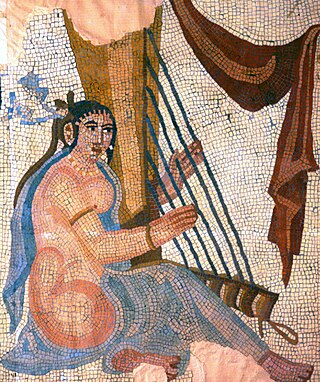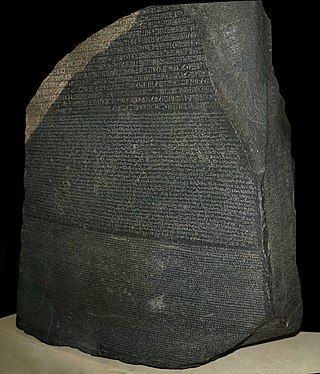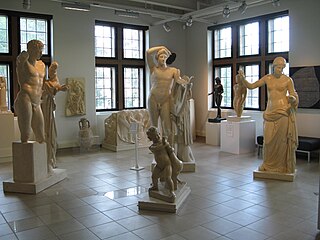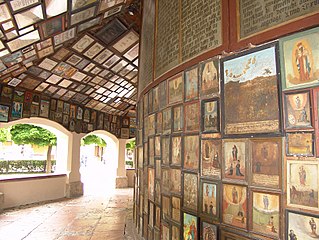
Sculpture is the branch of the visual arts that operates in three dimensions. Sculpture is the three-dimensional art work which is physically presented in the dimensions of height, width and depth. It is one of the plastic arts. Durable sculptural processes originally used carving and modelling, in stone, metal, ceramics, wood and other materials but, since Modernism, there has been almost complete freedom of materials and process. A wide variety of materials may be worked by removal such as carving, assembled by welding or modelling, or moulded or cast.

Dodona in Epirus in northwestern Greece was the oldest Hellenic oracle, possibly dating to the 2nd millennium BCE according to Herodotus. The earliest accounts in Homer describe Dodona as an oracle of Zeus. Situated in a remote region away from the main Greek poleis, it was considered second only to the Oracle of Delphi in prestige.

The lyre is a stringed musical instrument that is classified by Hornbostel–Sachs as a member of the lute family of instruments. In organology, a lyre is considered a yoke lute, since it is a lute in which the strings are attached to a yoke that lies in the same plane as the sound table, and consists of two arms and a crossbar.

The Falisci were an Italic tribe who lived in what is now northern Lazio, on the Etruscan side of the Tiber River. They spoke an Italic language, Faliscan, closely related to Latin. Originally a sovereign state, politically and socially they supported the Etruscans, joining the Etruscan League. This conviction and affiliation led to their ultimate near destruction and total subjugation by Rome.

In the history of art, prehistoric art is all art produced in preliterate, prehistorical cultures beginning somewhere in very late geological history, and generally continuing until that culture either develops writing or other methods of record-keeping, or makes significant contact with another culture that has, and that makes some record of major historical events. At this point ancient art begins, for the older literate cultures. The end-date for what is covered by the term thus varies greatly between different parts of the world.

Ancient music refers to the musical cultures and practices that developed in the literate civilizations of the ancient world, succeeding the music of prehistoric societies and lasting until the post-classical era. Major centers of ancient music developed in China, Egypt, Greece, India, Iran/Persia, the Maya civilization, Mesopotamia, and Rome. Though extremely diverse, the music of ancient civilizations is frequently characterized by monophony, improvisation, and the dominance of text in musical settings.

Music was ubiquitous throughout Mesopotamian history, playing important roles in both religious and secular contexts. Mesopotamia is of particular interest to scholars because evidence from the region—which includes artifacts, artistic depictions, and written records—places it among the earliest well-documented cultures in the history of music. The discovery of a bone wind instrument dating to the 5th millennium BCE provides the earliest evidence of music culture in Mesopotamia; depictions of music and musicians appear in the 4th millennium BCE; and later, in the city of Uruk, the pictograms for ‘harp’ and ‘musician’ are present among the earliest known examples of writing.

A curse tablet is a small tablet with a curse written on it from the Greco-Roman world. Its name originated from the Greek and Latin words for "pierce" and "bind". The tablets were used to ask the gods, place spirits, or the deceased to perform an action on a person or object, or otherwise compel the subject of the curse.

In epigraphy, a multilingual inscription is an inscription that includes the same text in two or more languages. A bilingual is an inscription that includes the same text in two languages. Multilingual inscriptions are important for the decipherment of ancient writing systems, and for the study of ancient languages with small or repetitive corpora.

There are literary, archaeological, epigraphic and numismatic sources of ancient Tamil history. The foremost among these sources is the Sangam literature, generally dated to 5th century BCE to 3rd century CE. The poems in Sangam literature contain vivid descriptions of the different aspects of life and society in Tamilakam during this age; scholars agree that, for the most part, these are reliable accounts. Greek and Roman literature, around the dawn of the Christian era, give details of the maritime trade between Tamilakam and the Roman empire, including the names and locations of many ports on both coasts of the Tamil country.

The Archaeological Museum of Nafplio is a museum in the town of Nafplio of the Argolis region in Greece. It has exhibits of the Neolithic, Chalcolithic, Helladic, Mycenaean, Classical, Hellenistic and Roman periods from all over southern Argolis. The museum is situated in the central square of Nafplion. It is housed in two floors of the old Venetian barracks.

Funerary art is any work of art forming, or placed in, a repository for the remains of the dead. The term encompasses a wide variety of forms, including cenotaphs, tomb-like monuments which do not contain human remains, and communal memorials to the dead, such as war memorials, which may or may not contain remains, and a range of prehistoric megalithic constructs. Funerary art may serve many cultural functions. It can play a role in burial rites, serve as an article for use by the dead in the afterlife, and celebrate the life and accomplishments of the dead, whether as part of kinship-centred practices of ancestor veneration or as a publicly directed dynastic display. It can also function as a reminder of the mortality of humankind, as an expression of cultural values and roles, and help to propitiate the spirits of the dead, maintaining their benevolence and preventing their unwelcome intrusion into the lives of the living.

The Archaeological Museum of Dion is a museum in Dion in the Pieria regional unit of Central Macedonia, Greece.
Roman Inscriptions of Britain is a 3-volume corpus of inscriptions found in Britain from the Roman period. It is an important reference work for all scholars of Roman Britain. This monumental work was initiated by Francis J. Haverfield, whose notebooks were bequeathed to the University of Oxford. The first volume, Inscriptions on Stone, was then edited by R.G. Collingwood and R.P. Wright with an addendum by R.S.O. Tomlin. It was first published in 1965, with a new edition in 1995.

The Museum of Antiquities is an archaeological museum at the University of Saskatchewan in Saskatoon, Canada. It opened in 1974 to provide an opportunity to study ancient works. The museum currently features a variety of Greek and Roman sculpture, and contains a collection of Near Eastern, Egyptian, Byzantine, Islamic and Medieval art. It is one of only a handful of museums of its kind in Canada.

Ceramic art is art made from ceramic materials, including clay. It may take varied forms, including artistic pottery, including tableware, tiles, figurines and other sculpture. As one of the plastic arts, ceramic art is a visual art. While some ceramics are considered fine art, such as pottery or sculpture, most are considered to be decorative, industrial or applied art objects. Ceramic art can be created by one person or by a group, in a pottery or a ceramic factory with a group designing and manufacturing the artware.

A votive offering or votive deposit is one or more objects displayed or deposited, without the intention of recovery or use, in a sacred place for religious purposes. Such items are a feature of modern and ancient societies and are generally made to gain favor with supernatural forces.
Tel Mevorakh is a small mound situated on the southern bank of Nahal Taninim in Israel. The tel does not exceed 1 dunam but rises to a height of 15 metres (50 ft) above its surrounding plain. The site contains some fifteen layers of human settlement, which accumulate to a height of 8 meters, meaning the natural hill does not exceed a height of 7 meters. It is located on the border between the wide Sharon Plain and the coast of Mount Carmel.

Pottery for oil is the generic term for ceramic objects, whether coarse or glazed, used for the transportation, storage, and consumption of oily products, particularly olive oil and its culture. Among the most popular items in this category of earthenware are oil cruets and alcuzas, cantarillas, orzas, amphoras, and jars for food; unguentarys and redomas in ancient pharmacopeia; and lamps and lucernas for lighting.





















